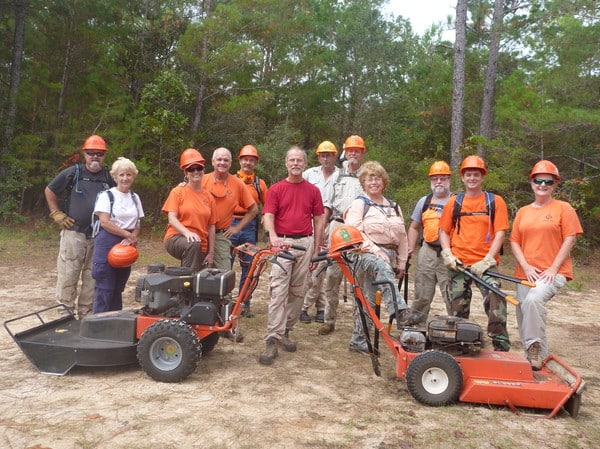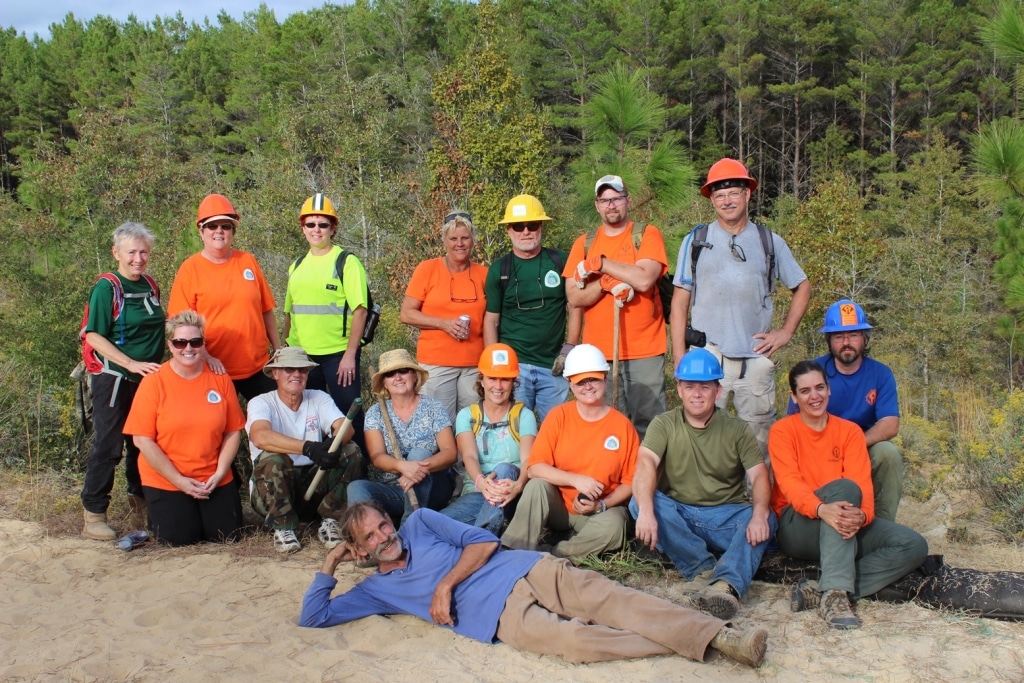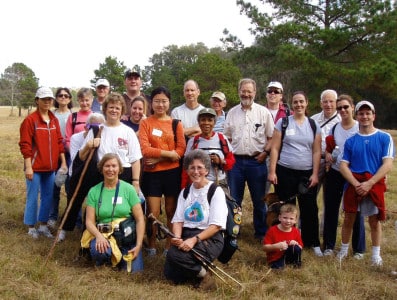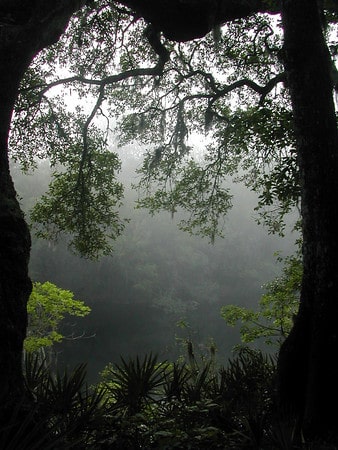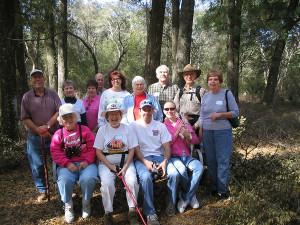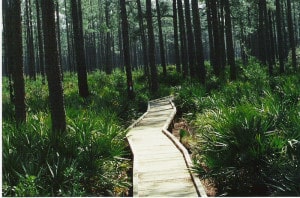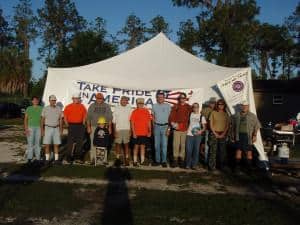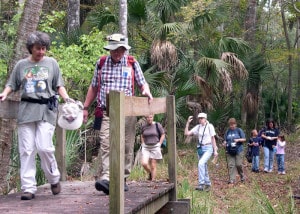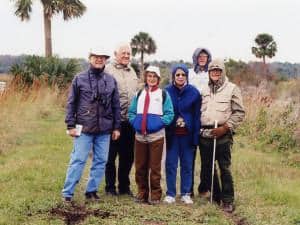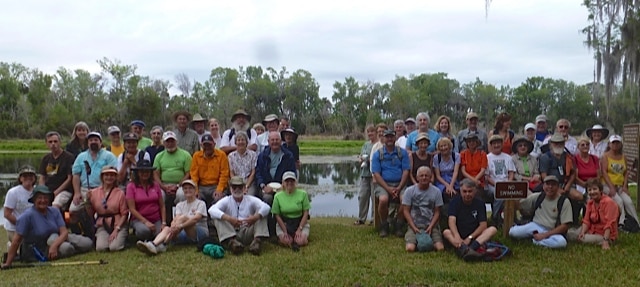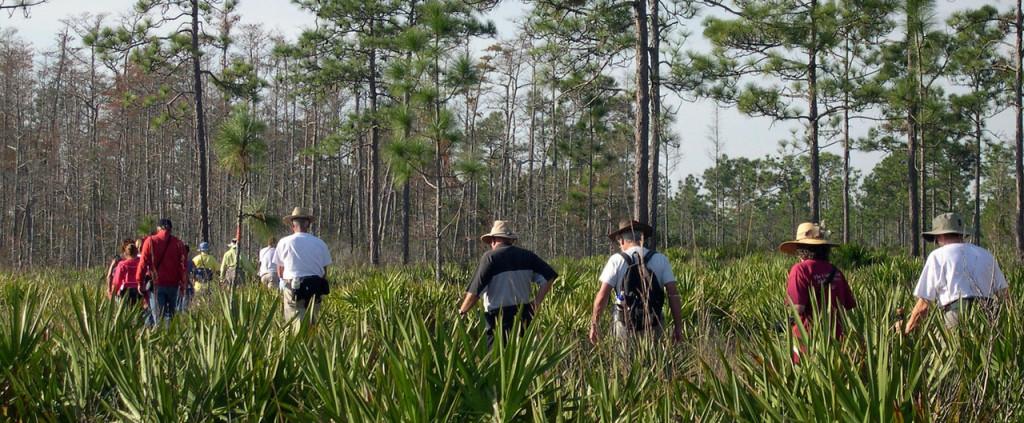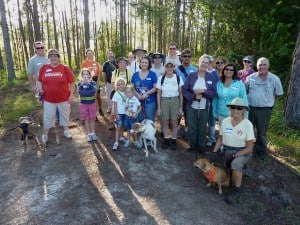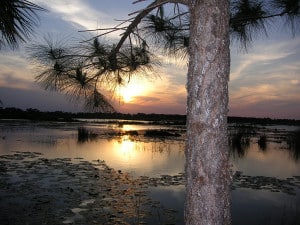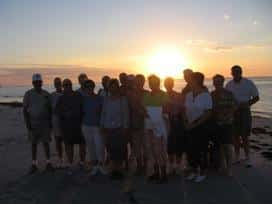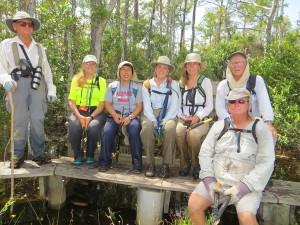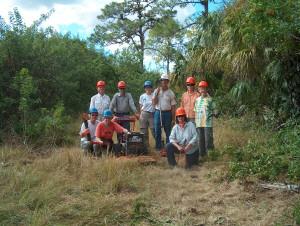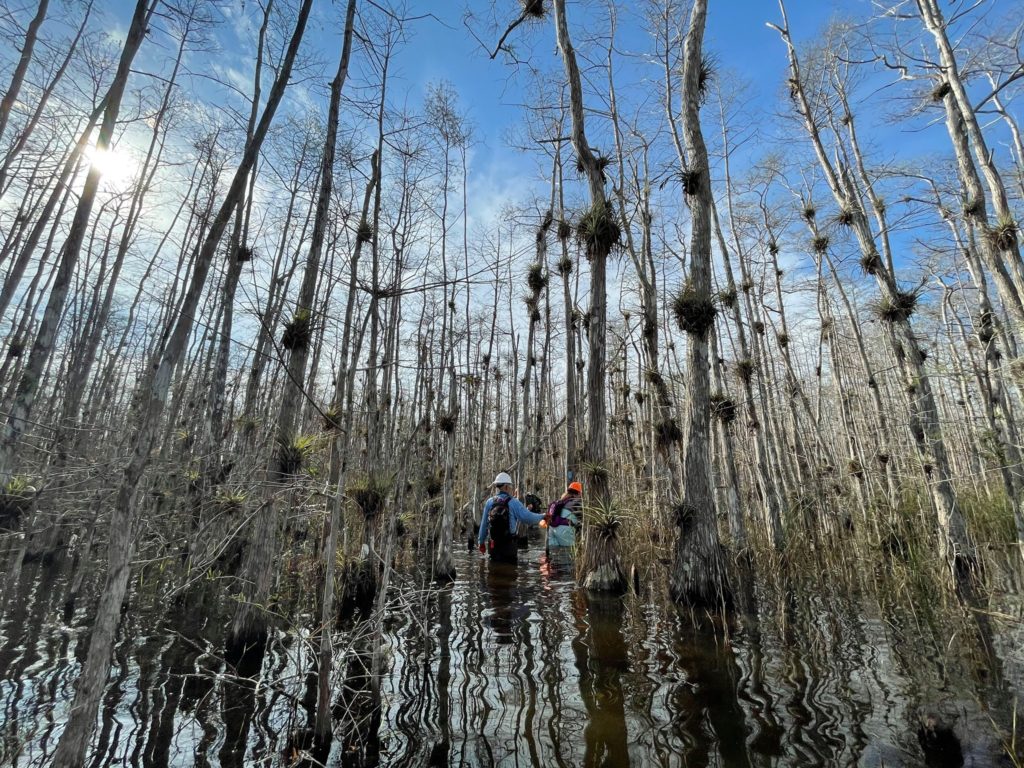Our Chapters
Building More Than Trails
The heart of the Florida Trail Association exists within our 19 statewide chapters. Each chapter hosts maintenance projects, outdoor activities, and monthly chapter meetings. Find a local chapter near you!
If you have trouble finding or contacting your local chapter please email us [email protected]
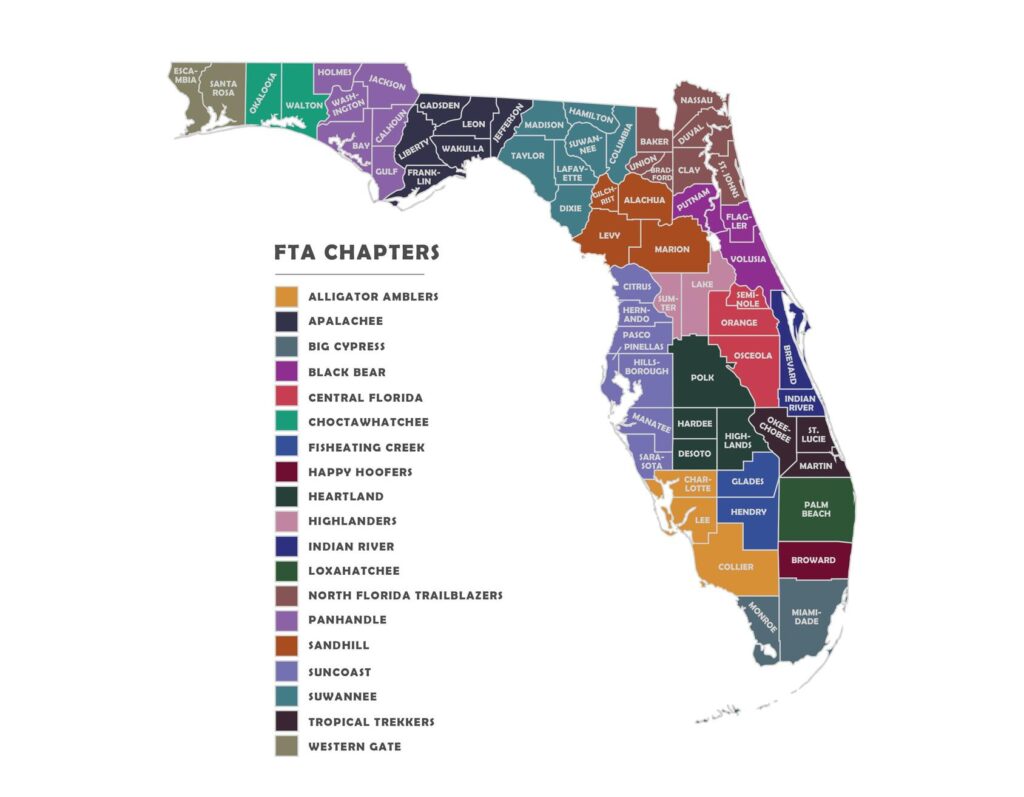
Western Gate
1 of 19Choctawhatchee Chapter
2 of 19Panhandle
3 of 19Suncoast
4 of 19Apalachee
5 of 19Suwannee
6 of 19Trailblazers
7 of 19Sandhill
8 of 19Black Bear
9 of 19Highlanders
10 of 19Central Florida
11 of 19Heartland
12 of 19Alligator Amblers
13 of 19Fisheating Creek
14 of 19Loxahatchee
15 of 19Happy Hoofers
16 of 19Big Cypress
17 of 19Indian River
18 of 19Tropical Trekkers
19 of 19The Chapter’s annual events and activities include the Panhandle Trace Hike, a multi-day event during the spring with day hikes on the various trails managed by the Western Gate Chapter. Participants can hike one or more days of this event. Other ongoing events include trail maintenance activities every Thursday and on the second Saturday of each month.
The Western Gate Chapter builds and maintains the trails within the Florida Trail System that are located in Escambia and Santa Rosa counties in the Florida Panhandle. These trails are managed under four sections: Seashore, Weaver Creek, Yellow River Ravines, and Blackwater River State Forest. The Chapter also maintains the Garcon Point Loop Trail where spectacular fields of carnivorous pitcher plants grow.
Seashore: The Gulf Islands National Seashore is the northern terminus of the Florida Trail and home to the only National Scenic Trail beach hike in the nation. Get immersed in colonial history at the trailhead at historic Fort Pickens. Take in the sights of our Florida Trail Gateway Community in Pensacola Beach. Travel through the unique ecological environment of pine trees, yucca plants, sea oats and dunes while seeing the many raccoon tracks and osprey nests and searching for the elusive Santa Rosa Island Beach Mouse. Or, simply enjoy a walk along the beach through sparkling white quartz sand beside the beautiful emerald waters of the Gulf of Mexico. A backcountry campsite is located along the Dunes Trail area facing Santa Rosa Sound.
Weaver Creek: Weaver Creek Trail is located on the western edge of Eglin Air Force Base (AFB), stretching approximately 14 miles between Navarre and the Yellow River. Hikers meander through upland pines and oaks, cross a beautiful spring-fed stream and pass through a large, picturesque steephead. Other points of interest include enjoying the shady coolness of titi swamps, crossing lichen-covered hillsides, and two backcountry campsites: Dean Campsite in the south and Buck Pond in the north. Since this trail is located on Eglin AFB, recreational and camping permits are required (contact Eglin AFB -Jackson Guard at 850-882-4165 or go to https://eglin.isportsman.net for permit purchases).
Yellow River Ravines: This section, which runs in a mostly northeast/southwest direction between Log Lake Road and State Road 87, passes through a variety of terrain along the north side of the Yellow River. Near the northeast end, a camping opportunity is available near Guest Lake Park. Reaching Deer Lake Junction, hikers may choose to head to Ft. Pickens in Gulf Islands National Seashore on the main trail, with the Wild Azalea backcountry campsite along this route. There is, currently, a six-mile road walk on the western end of this section that connects with the Weaver Creek Section. New trail is currently under construction to replace the road walk. Hikers choosing to head north from Deer Lake Junction toward Alabama on the blue-blazed side trail, can camp at Burnt Grocery Creek backcountry campsite.
Blackwater River State Forest: Heading north from Yellow River Ravines, hikers enter one of the largest state forests in Florida named after the Blackwater River. Trails maintained by the Chapter include the Hutton Unit, Juniper Creek, Jackson, and Wiregrass. The Juniper Creek Trail provides access to Blackwater River State Park, while the Jackson Trail provides access to recreation areas at Bear, Krul, Karick, and Hurricane Lakes and links to the Wiregrass Trail, which continues north to the Florida/Alabama state line. The state forest is home to a longleaf pine/wiregrass ecosystem. Blackwater River and Juniper Creek, with their white sandy beaches and river bluffs, are accessible at many spots along the trails. Other special features include pitcher plant bogs, blueberries, mountain laurel, rhododendron, and wild azalea. Wildflowers can be found blooming at many spots along the trail in the spring and fall.
Choctawhatchee Chapter
The Choctawhatchee Chapter of the Florida Trail Association, chartered in January 2006, builds and maintains trails on Eglin Air Force Base Reservation, Northwest Florida Water Management District land, and Nokuse Plantation. The chapter is home to the Florida Trail Gateway Community of Crestview. Major chapter activities include the Eglin Traverse, the Summer Sweat Hike, the Shoal River Float and Picnic, the Bear Lake Night Hike and Potluck, and the spring Yellow River swamp hike in the Cimarron Section.
Eglin Air Force Base of the Florida Trail provides over 60 miles of excellent hiking for day trips or backpacking on land that once was part of Choctawhatchee National Forest. Seven primitive campsites are located along the trail. An Eglin Recreation Permit is required and can be obtained at the Eglin Natural Resources Branch: 850-882-4164.
The Nokuse Section of the Florida Trail meanders 19 miles on Northwest Florida Water Management District land and the Nokuse Plantation conservation corridor where the ecosystem is being restored and preserved to support native plants and animals. Two primitive campsites are located along the trail.
Panhandle Chapter
The Panhandle Chapter of the Florida Trail Association was formed in 1982 to serve the central and western region of the Florida panhandle (west of the Apalachicola River). Later the Choctawhatchee and Western Gate Chapters were organized to serve the western end of the panhandle. Today the Panhandle Chapter serves six counties in the central panhandle area of Florida, between the Choctawhatchee and Apalachicola Rivers. The Panhandle Chapter’s maintenance section of the Florida Trail is divided into three Sections, including, from west to east, the Pine Log Section, the Econfina Section, and the Chipola Section.
The first major job of the Panhandle Chapter, in the late 1980s, was to build eight miles of wilderness trail through Pine Log State Forest in the Chapter’s Pine Log Section. Their next challenge, in the late 1990s, was to construct 18 miles of wilderness trail through the Econfina Creek Water Management Area in the Econfina Section. Since then the Chapter has built and now maintains the Altha Trail, and adopted the Blountstown Greenway, all within the Chipola Section.
Trails the Panhandle Chapter Maintains:
Pine Log Section | Econfina Section | Chipola Section
Apalachee Chapter
Since 1982, the Apalachee Chapter of the Florida Trail Association has brought hikers together throughout the Capital Region surrounding Tallahassee. The Apalachee Chapter has the distinction of maintaining the first certified section of the Florida National Scenic Trail, certified by the USDA Forest Service in 1988.
The chapter is home to the Florida Trail Association Tallahassee office. In addition to a wide slate of activities year-round, the chapter holds the Annual Bradwell Bay Wilderness Swamp Stomp each March in the heart of the Apalachicola National Forest, where participants slog about 8 miles through one of the largest swamp forests in Florida along a section of the Florida Trail once rated by Backpacker magazine as one of the 10 toughest hikes in the United States.
The Apalachee Chapter maintains the Florida Trail from the Aucilla River west to the Apalachicola River, including the Aucilla River & Sinks Water Management Areas, St. Marks National Wildlife Refuge, and the Apalachicola National Forest. In addition, members maintain loop trails at Fort Braden (Lake Talquin State Forest), Phipps Park, and Torreya State Park.
The Apalachicola Section of the Florida Trail offers delights for the day hiker and challenges for the backpacker on its 77 mile journey. Along the Sopchoppy River, there is fragrant wild azalea in spring and spectacular scenic views; in the Bradwell Bay Wilderness, it’s a challenge best shared as you wade through nearly 8 miles of deep swamp hiding virgin stands of cypress and pine. Rare pitcher plants bloom in the western prairies of the forest each spring.
In St. Marks National Wildlife Refuge, the Florida Trail has the distinction of being the only National Scenic Trail that skirts along the sea, here overlooking the Gulf of Mexico. Backpackers enjoy the rare privilege of camping inside the refuge (permit required) when hiking this 50 mile section, and encounter historic sites such as the Port Leon ghost town and natural wonders like expanses of salt marshes, The Cathedral of Palms and Shepherd Spring.
Suwannee Chapter
In 1992, the Suwannee Chapter of the Florida Trail Association stood on its own two feet after several years as the “Sandhill’s Kinfolk,” a subchapter of the Sandhill Chapter, based in Gainesville. Active in local events like the Florida Folk Festival, members of the Suwannee Chapter maintain the Florida Trail system through private timberlands, through Twin Rivers State Forest, and Suwannee River State Park.
Activity leaders lead hikes, paddling trips, trail maintenance, and birding trips throughout the vast “Original Florida” region, from the shores of Steinhatchee to a rail trail along the Georgia border with Madison County. With special interests in Florida folklife and history, members of the Suwannee Chapter provide many informative programs and hikes with a historic twist, including establishing a new trail to the Drew Mansion Ruins along the Suwannee River.
The Suwannee chapter maintains the Florida Trail from the Econfina River in the Big Bend east to Suwannee River State Park at Ellaville, including riverfront hiking along the Suwannee and Withlacoochee Rivers, and the Big Oak Trail and the Drew Mansion Ruins Trail, both loop trails at Suwannee River State Park.
Trails that the Suwannee Chapter maintains: Ellaville, Big Oak Trail, &
Drew Mansion Ruins Trail is our newest loop trail, providing a short interpretive walk into Florida’s Reconstruction Era history on the grounds of the former mansion of Governor George Drew. This short trail is off old US 90 just west of the Suwannee River.
Sandhill Chapter
The Sandhill Chapter of the Florida Trail Association has brought together North Central Florida’s hikers since it was chartered in 1980, when the first meetings were held in member’s living rooms. The chapter hosted the very first North Regional Fall Conference in 1983 at Suwannee River State Park and has participated in every state and North Regional conference since. A subchapter, the Sandhill ’s Kinfolk, became the Suwannee Chapter.
Members of the Sandhill Chapter have built many bridges over the deep gorges along the Suwannee River, and, working in coordination with biking and equestrian groups, built a 35-mile segment of trail through Marion County along the Cross Florida Greenway, crossing the prominent 3.3 million dollar Land Bridge over I-75 between Belleview and Ocala.
The chapter schedules a variety of activities each month such as day hikes, picnics, kayak/canoe trips, overnight pack trips and bicycle outings.
The Sandhill Chapter maintains the Florida Trail along the Suwannee River from Suwannee River State Park east to White Springs and along the length of the Cross Florida Greenway between Dunnellon and the Eastern-West Corridors junction in the Ocala National Forest.
Cross Florida Greenway has been a premier destination for day hikers and backpackers since its debut in 2000. Offering both short loop hikes (at the Land Bridge and Ross Prairie trailheads) and a linear 35-mile corridor for long distance outings, this section of trail takes hikers on a walk through history, following the route of the failed 1930’s effort to build a Cross Florida barge canal. Of interest are the canal diggings, some of which fill with water and become lakes during the rainy season, and some of which resemble tall sand dunes. Access the trail from trailheads along CR 484, SR 200, CR 475A, SW 49th Av, SE 80th St, Baseline Rd, and Sharpes Ferry Road.
The Florida Trail along the Suwannee River provides some of North Florida’s most rugged hiking, scrambling in and out of natural drainages , skirting enormous sinkholes, springs, natural bridges, and waterfalls. It’s a place of geological delights, accessed from trailheads at Holton Creek WMA, Suwannee Springs, Stephen Foster State Park, and Camp Branch.
North Florida Trailblazers Chapter
Established as the Cornelian Hiking Club in 1981 in honor of Cornelia Burge, one of the Florida Trail’s most memorable volunteers, the North Florida Trailblazers took on their new name in 1987. Our chapter, which maintains the Florida Trail in the northeasternmost part of the state, has a very active core group and our members participate at both the local and state level.
When we are not blazing, we can be found on trails near and far from Jacksonville. We celebrate the end of the year at our annual Christmas Campout with a potluck and presents. Usually held at Osceola National Forest’s group site, The Landing, this is a long weekend of great fun and outdoor activities. Saturday night features fried turkey and all the fixings and no one wants to miss out on the gift exchange! In February, we host the annual IDIDAHIKE – a 12 mile hike with shorter routes, as well. This is our main fundraiser of the year, and has been a great success. During the rest of the year, you’ll find us keeping the trails clear and leading hikes and other activities. Come join us!
The North Florida Trailblazers Chapter maintains the Florida Trail from the Tinsley Road trailhead at Etoniah Creek State Forest to the town of White Springs. The trail passes through Gold Head Branch State Park, Camp Blanding, the Keystone Airpark, portions of the Palatka-Lake Butler rail corridor, the town of Lake Butler, and the Osceola National Forest.
While we think that all of our trails are very special, during the spring when many of Florida’s native plants are in bloom, you’ll find one of the best smelling sections of trail along the Suwannee River between the Little Shoals Trailhead and White Springs. Depending upon weather conditions, blooming can begin as early as the beginning of March. Along this stretch of trail you’ll find native azalea, Florida fringe trees, and button bushes as well as a host of other flora. The azaleas range in color from dark pink to almost white and are clustered close to the trail in many places. Their heady fragrance fairly drips upon your head as you pass by.
Suncoast Chapter
On one of the coldest days on record in January of 1981 seventy five people gathered to form what would become the Suncoast Chapter of the Florida Trail Association. Officially chartered in August 1981, the Suncoast Chapter now serves a seven county area in west central and southwest Florida. With over 500 members it is the FTA’s largest chapter.
Active members lead and participate in many activities, including a yearly clam bake, the popular Sunday morning Exercise Walk at Lettuce Lake Park, and the long running annual Stone Soup gathering each January. The chapter regularly maintains over 200 miles of trail and offers recreational events throughout the region.
The Suncoast chapter maintains the Florida Trail between US 98 north of Lakeland and Hernando, including all of the Withlacoochee State Forest.
Loop trails maintained include Citrus, Croom, Green Swamp West, Hillsborough River State Park, Little Manatee State Park, Myakka River State Park, Potts Preserve, Richloam, Upper Hillsborough and Withlacoochee River Park.
The Citrus Hiking Trail is the state’s longest backpacking loop trail in a single contiguous forest. With rolling sand hills, descents into sinkholes and the occasional rock-strewn footpath these trails have terrain and elevation changes uncommon to Florida.
The Croom Tract Loop Trail is a favorite for backpackers training for strenuous mountain treks, as it is one of Central Florida’s more rugged hikes. The “low water” route passes through cypress stands with some immense trees, while the “high water” route heads right up into the sandhills to access the three backpacking loops. Loop A is part of the Florida State Forests Trailwalker Program.
Myakka River State Park is one of the oldest and largest state parks in Florida. It is well known for its abundant wildlife. The Myakka Hiking Trail meanders through hammocks of live oak and cabbage palm, across open palmetto flatwoods and along small marshes. The trail traverses broad open prairies up to two miles across, a preserved remnant of Central Florida’s original grasslands.
Black Bear Chapter
Originally founded as the Bellamy Chapter, named after Bellamy Road, the first major US federal highway in early territorial Florida. Then for a number of years the chapter was named the Halifax-St. Johns Chapter (named after the two rivers on the east and west sides of the Chapter), the Black Bear Chapter was renamed to it’s current name in 2015 to better identify it with the large population of wilderness inhabitants in the natural environment that the trail traverses.
The Black Bear Chapter maintains about 100 miles of the Florida National Scenic Trail in northern Ocala National Forest north of SR 40, including both the Eastern and Western Corridors, plus the Florida Trail over Rodman Dam and continuing over and north of Buckman Lock, through Rice Creek Conservation Area and Etoniah Creek State Forest. The Black Bear Chapter also maintains loop trails, including the Rice Creek Loop section, the Bella Vista Trail at Washington Oaks Gardens State Park and the St. Francis Hiking Trail in southeastern Ocala National Forest.
The Black Bear Chapter is continuing to add more recreational opportunities and improve Chapter meetings. One of the Chapter’s popular annual events is the St. Francis weekend trail backpack camping and mayoral election in February around Valentine’s Day.
Rice Creek: A natural haven with a touch of history, the Florida Trail along Rice Creek traverses land that was once a British rice and indigo plantation in the 1700s. Along the creek, ancient cypresses tower above the forest canopy, sentinels watching over the tannic flow. The floodplain forest along the creek is lush and green, with many bromeliads in the trees and many boardwalks and bridges to cross. The Rice Creek section can be accessed from a trailhead on SR 100, several miles west of Palatka.
Ocala Forest North: One of the most popular destinations for backpackers on the Florida Trail, the northern portion of the Ocala National Forest winds through a wilderness of open prairies, shady oak hammocks, desert-like scrub, and vast forests of longleaf pine where the understory view goes on forever. There is approximately nine miles of the Florida National Scenic Trail through the designated wilderness at Juniper Prairie Wilderness Area, a unique and popular camping, hiking and wildlife viewing wilderness environment, including the well known Hidden Pond. Juniper Prairie Wilderness offers a perfect habitat for the Florida scrub jay, the only species of bird endemic to Florida. Access the trail via some of the trailheads, including Juniper Springs Recreation Area, Pat’s Island, Hopkins Prairie, Grassy Pond, Lake Delancy, Rodman Campground, and Buckman Lock.
Highlanders Chapter
Since 1997, the Highlanders Chapter of the Florida Trail Association has provided a gathering place for hikers in the heart of Central Florida.
The chapter regularly maintains 56 miles of the Florida Trail and offers educational seminars and recreational events throughout the region. Many hiking and kayaking events that are also planned by members and published in the Highlanders Newsletter.
The Highlanders chapter maintains the Florida Trail in the Ocala South Section in the National Forest, as well as the Cassia Section including the north part of Seminole State Forest, Royal Trails segment, and LaNoChe Boy Scout Camp segment. They are also responsible for the Croom Hiking Trail running from Hog Island to River Junction in Withlacoochee State Forest in south Sumter County. They also maintain one loop trail, the Daubenmire Trail in Flat Island Preserve, in Leesburg.
The Florida Trail through the southern Ocala National Forest was the first section of the Florida Trail blazed in October, 1966. Extending from Clearwater Lake north to SR 40, this segment is one of the most popular in the state for backpacking, with highlights including Farles Prairie and Alexander Springs.
Flat Island Preserve is an easy 3.5 mile loop on an island in the Okahumpa Marsh and features an incredible amount of botanical diversity for Central Florida. It’s a popular destination for beginner backpacking trips and is just off US 27 south of Leesburg.
In Seminole State Forest the Florida Trail meanders through dense cabbage palms stands and across broad palmetto prairies while leading hikers past unique sites like Shark Tooth Spring and Blackwater Creek.
Central Florida Chapter
The Central Florida Chapter was chartered in 1981 and is one of FTA’s largest chapters with more than 500 members. Our active members lead and participate in many activities, including the popular TGIF “after work” hikes, Historical Hikes in the Central Florida area, the Winter Wednesday Hike Series, and a variety of other hiking, biking, paddling, camping and trail maintenance activities. Each Thanksgiving we have a group camping event at a local state park or forest and each New Years we “retreat” to the Ocala National Forest for a fun-filled camp out and celebration.
The Central Florida Chapter maintains Florida National Scenic Trail through Seminole Ranch WMA, C.H. Bronson State Forest, Chuluota Wilderness, Mills Creek Woodlands, Little Big Econ State Forest, Cross Seminole Trail (multi-use), Greenwood-Crossings Trail (multi-use), Seminole-Weikiva Trail (multi-use), Lower Wekiva River Reserve State Park and Seminole State Forest (south of Blackwater Creek).
Loop and Side Trails maintained include; the Orlando Wetlands Trails, Wekiwa Springs State Park Trails, the Lower Wekiva Loop Trail in Seminole State Forest, the River Trail in C.H. Bronson State Forest, the Culpepper Spur Trail and the Kolokee Loop Trail in Little Big Econ State Forest.
DID YOU KNOW? The American Hiking Society named the Florida Trail in Little Big Econ State Forest as one of the top family-friendly hikes in the United States.
Little Big Econ State Forest is a popular destination for day hikers in the Orlando metro area. Accessible from trailhead parking areas in Chuluota along Snow Hill Road and Oviedo at the Barr Street Trailhead off SR 426 and at Lockwood Road, Oviedo, the Florida Trail runs 7.3 miles through extraordinarily scenic terrain, following the river bluffs and river bottom forests along the Econlockhatchee River. Hikers enjoy unobstructed river views from several points along the trail, including the new Econ River Bridge on the Flagler Trail. With a trail shaded by towering cabbage palms, dense stands of cypress, and grand live oaks, it’s a hike you shouldn’t miss.
Wekiwa Springs State Park is the busiest park in the Florida State Parks system, popular for picnicking, paddling, camping, swimming in the springs, and hiking. The Wekiwa Springs Hiking Trail includes a deeply shaded 1.9-mile linear trail between Wekiwa Spring and Sand Lake, and a 7.2 mile loop trail through scrub, pine flatwoods, cypress swamps, and hard wood forests that starts and ends at the Sand Lake parking area. Backpackers can take advantage of Camp Cozy, a scenic destination along Rock Springs Run.
Indian River Chapter
In 1981, the Indian River Chapter of the Florida Trail Association first brought hikers together along the Space Coast. Serving Brevard and Indian River counties, the chapter is responsible for lengthy stretches of the Florida Trail through the eastern edge of Osceola County.
The Indian River chapter has more than 200 members. Through their membership and Meetup group offers frequent opportunities for its wider community to experience the outdoors. Activities include not only trail maintenance hikes, but also leisure hikes and camping, backpacking, sightseeing, swimming, and paddling. We offer full moon hikes, beach strolls, and lighthouse tours.
The Indian River Chapter maintains 120 miles of trail, including the Florida Trail from Tosohatchee WMA south through Bull Creek WMA, Forever Florida, Three Lakes WMA, and Prairie Lakes WMA.
Our newest trail is the Triple N Ranch Trail, a new loop trail in the Florida Trail System, located near Holopaw off US 192.
The Florida Trail in Prairie Lakes Wildlife Management Area offers two loops, providing a place for hikers to enjoy day hikes and extended backpacking trips. A side trail off the loop leads to an observation deck over the Lake Kissimmee marshes. This vast wilderness in Osceola County is off Canoe Creek Road between Holopaw and Kenansville.
Triple N Wildlife Management Area is the location of our newest loop trail. Walk into Florida’s pioneer past through palmetto prairies and past cypress domes in this classic Central Florida landscape, off US 192 west of Melbourne.
Tosohatchee Wildlife Management Area is a popular day hike and weekend backpacking destination off SR 50 west of Titusville. The Florida Trail tunnels through dense old-growth forests and a side trail leads to a rare stand of virgin cypress trees.
The Base Camp Outlet for camping and skiing supplies is located at 908 US 1 in Rockledge. Base Camp assists in the distribution of our newsletter, the FOOTLOG.
Heartland Chapter
Organized in 1976 as the Lake Kissimmee Chapter of the Florida Trail Association, the Heartland Chapter covers the heart of Central Florida, from the Green Swamp south through the southern reaches of the Lake Wales Ridge, along both the Peace and Kissimmee Rivers.
The chapter began with trail building and maintenance as our primary mission, and completed the initial building and maintenance of the trails in the Richloam Tract of Withlacoochee State Forest as well as Hickory Hammock along the Kissimmee before turning these trails over to adjoining chapters. In addition to numerous side and loop trails on public lands, the chapter maintains a swath of the Florida National Scenic Trail from the Green Swamp to Bluff Hammock.
Under the guidance of master carpenter Roland Alderman, bridge building became the chapter’s forte. Many of our original bridges withstood the hurricanes of 2004. There are always new trails being blazed under the direction of our dedicated section leaders and advisors. We invite you to come out and hike with us!
The Heartland Chapter maintains the Florida Trail through Green Swamp East and along the Kissimmee River between SR 60 and Bluff Hammock. The chapter also takes care of loop trails at Lake Kissimmee State Park, Avon Park Air Force Range, Lake Wales Ridge State Forest, Tenoroc FMA, Tiger Creek Preserve, Saddle Creek Park, and Paynes Creek Historic State Park.
Along the Kissimmee River, the Florida Trail follows a historic cattle drovers route, passing through hammocks that once sheltered pioneer homesteads and through the ghost town of Kicco. Wooden sidewalks and a cemetery are reminders of an era of steamboat travel on the Kissimmee River more than a century ago. Scenic views of the river are interspersed with walks through the woods and bridge crossings over sloughs.
Lake Kissimmee State Park is one of Central Florida’s most popular weekend backpacking destinations thanks to two gentle but interesting loop trails. Both the Buster Island Loop and the North Loop keep hikers in the shade of ancient oaks for the majority of their walk, and provide beautiful primitive campsites under the spreading oak trees. The park is unparalleled for wildlife watching. You’ll see many deer as well as rare creatures like the Florida scrub-jay and Audubon’s Crested Caracara.
Tropical Trekkers Chapter
Since 1996, the Tropical Trekkers Chapter of the Florida Trail Association has brought together hikers along the Treasure Coast. They are a voice for their local hiking community, with members serving on advisory boards for state parks and working with Martin County to develop a long-range master plan for parks and recreation.
Some of their annual activities include the Annual Desert Hike, typically held on the Hawks Bluff Trail in Savannas State Park, and an annual AT backpacking trip. The Tropical Trekkers spend hundreds of hours each year maintaining trails and fulfilling the mission of the Florida Trail Association to instill in Floridians an appreciation of the natural beauty of Florida.
The Tropical Trekkers maintain the Florida Trail along the Kissimmee River from Okeetantie Recreation Area (near Okeechobee) to Bluff Hammock Conservation Area. The Tropical Trekkers maintain the Florida Trail along the Kissimmee River from Okeetantie Recreation Area (near Okeechobee) to Bluff Hammock Conservation Area. The chapter also played a major role in establishing the Micco Bluff section (estab. 2018), a new 11.9 mile section of trail between Micco Landing Trailhead and Oak Creek Trailhead. This new re-route eliminated 8 miles of road walk along Micco Bluff road. The Trekkers now host an annual hike through the Micco Bluff section every spring.
Loop and side trails maintained within the Florida Trail System include Seabranch State Park, South Fork St. Lucie, and the new Rafael Sanchez Trail in Okeechobee Ridge Park.
The Florida Trail between the Hickory Hammock and Bluff Hammock trailheads is a beautiful section of footpath leading hikers from the parking area along US 98 through hydric hammocks dense with cabbage palms and wild citrus trees, past waterways brimming with lilies, and to a well-treasured campsite in Hickory Hammock, deeply shaded by live oaks and hickory trees. Along the northernmost portion of this 9.1 linear mile stretch of trail, several lengthy boardwalks and bridges carry hikers along the edge of the Kissimmee River floodplain, providing spectacular views for birding.
Seabranch Preserve State Park is one of the newest parks in the Florida State Parks system, and hiking is the way to enjoy this special preserve along the Intracoastal Waterway near Hobe Sound. Two loop trails totaling 4.8 miles provide your gateway to explore a coastal scrub habitat, increasingly rare in this region due to development. Hikers often see Florida scrub-jays and gopher tortoises here. The preserve includes a rare South Florida bayhead swamp, which the trail parallels.
Fisheating Creek Chapter
Serving Hendry and Glades Counties
WHO WE ARE
The Fisheating Creek Chapter serves Glades and Hendry Counties. The Florida National Scenic Trail (FNST) passes through Hendry County south of Clewiston and through Glades County on the west side of Lake Okeechobee. The Fisheating Creek chapter works with state and federal land managers to help with peripheral maintenance and trail safety on the FNST.
The Fisheating Creek chapter can be contacted via email: [email protected]
WHAT WE DO
The Fisheating Creek chapter advocated in 2023 for all of Glades County to be designated as an FTA Gateway Community. Gateway Communities are locations within 7 miles of the FNST in which local businesses and residents are supportive of and hospitable to trail users. In Glades County, two county parks are directly adjacent to the FNST, providing added infrastructure to support trail users. The chapter can typically be found distributing free trail info at local festivals in Glades County and surrounding counties January through April.
The Lake O’ Trail is multi-use and mostly paved, which is popular with both hikers and cyclists. The chapter hosts group cycling events regularly between November and June on the Lake O’ Trail, as well as the annual Cycling and Safety Expo in partnership with FDOT.
Chapter Activity Leaders regularly host leisurely hikes between November and June on various sections of the 110-mile Lake Okeechobee Scenic Trail, the three trails in the Fisheating Creek Wildlife Management Area and other WMA trails in Hendry County. Free tent camping is allowed anywhere along the Lake O’ Trail as well as in the Fort Center Trail area of the Fisheating Creek WMA (within agency rules).
The Fisheating Creek chapter can be contacted via email: [email protected]
Alligator Amblers Chapter
Serving hikers in Boca Grande, Cape Haze, Charlotte Harbor, Estero, Everglades City, Fort Myers, Marco Island, Naples, Pine Island, Placida, Punta Gorda, Sanibel & Captiva Islands (Charlotte, Collier, and Lee Counties)
Organized in 2000, the Alligator Amblers Chapter of the Florida Trail Association became a fully chartered chapter in 2002. The chapter offers a diverse slate of activities, from explorations of trails throughout the three-county region to kayak and biking activities and getaway weekends to other parts of the state for education and water-based recreation. Members have been instrumental in assisting local, county, and state agencies in establishing new trail systems at places like Fakahatchee Strand Preserve State Park and Hickey’s Creek Mitigation Park.
In conjunction with the Big Cypress Chapter, the Alligator Amblers assist in maintenance of the southernmost portion of the Florida Trail in Big Cypress National Preserve.
The chapter is also responsible for maintenance of the Collier Seminole Hiking Trail at Collier Seminole State Park.
The Florida Trail in Big Cypress National Preserve is one of the state’s most rugged places to hike. Winding through a haunting landscape of dwarf cypress rising from sawgrass, rare rocky islands topped with pine rocklands, colorful cypress sloughs festooned with dense bromeliads and orchids, and dense jungles of tall ferns. Slipping and sliding on wet marl and wading through ankle-to-knee deep dark water is a norm, and both day hikes and extended backpacking trips must be carefully planned. But the rewards are great: immersing yourself in one of Florida’s most diverse preserves, you truly get in touch with the wilderness.
The Collier-Seminole Hiking Trail is a rugged 6.5 mile loop just north of the Tamiami Trail, 9 miles east of Naples. Check in at the ranger station and ask for the gate combination before starting your hike. This wet landscape holds delights like colorful terrestrial orchids and the largest natural hammock of royal palms remaining in Florida. Bring mosquito protection!
Loxahatchee Chapter
Chartered in 1982, the Loxahatchee Chapter of the Florida Trail Association began with a core group of 36 outdoors enthusiasts, some of whom had participated in blazing a new trail through the Corbett Wildlife Management Area. Members soon after took on the task of blazing the Florida Trail around Lake Okeechobee and took over care of the major hiking trail in Jonathan Dickinson State Park to create a loop trail for backpackers and day hikers.
The chapter has many well established activities, including the Annual Ocean to Lake Backpacking Trip & Day hikes around President’s Day. Over the past decade, members have been instrumental in creating the Ocean to Lake Trail from Hobe Sound Beach on the Atlantic Ocean to Lake Okeechobee. Other hikes include the Mothers Day wildflower walk, first-weekend walks in John Prince Park and at Jonathan Dickinson State Park and, most famous of all, the annual “Big O” Hike around Lake Okeechobee each Thanksgiving week, a major event held every year since 1992.
The Loxahatchee Chapter maintains the Florida Trail around Lake Okeechobee, and the Ocean to Lake Trail from Hobe Sound to Port Mayaca., and also takes care of loop trails in Jonathan Dickinson State Park and DuPuis Reserve, and the linear portion of the Ocean to Lake Trail through Corbett WMA as well as Palm Beach County Natural Areas and Riverbend Park.
The Ocean To Lake Hiking Trail runs for approximately 63 miles, west from Hobe Sound Beach to Lake Okeechobee. The trail starts at the ocean, entering Jonathan Dickinson State Park at US 1, traveling through the park, Palm Beach County Natural Areas, Corbett Wildlife Management Area and Dupuis Management Area, and ends at the lake. The ecosystems on this beautiful trail change approximately every mile, from ancient sand dunes with scrub oak and sand pine to pine flatwoods, palmetto and oak hammocks, cypress swamp and wet prairies.
At Jonathan Dickinson State Park, the two loops that the chapter maintains (Green Loop and White Loop) provide great day hikes for exploring a range of habitats from open sand pine scrub to wet prairies, pine flatwoods, cypress domes, and dense hardwood hammocks. The trails have been rerouted in some areas. Backpackers can put the two loops together for nearly 18 miles of hiking, an excellent weekend outing. Access the Green Loop at the front parking area along US-1 next to the ranger station, north of Jupiter. Access to White Loop is from the Camp Murphy Trailhead approximately one mile down the road from the main entrance for JDSP.
The Corbett Hiking Trail across Corbett WMA in western Palm Beach County is lesser known but a true gateway to the wild. This 17-mile linear trail is now part of the Ocean to Lake Trail and connects the Everglades Youth Camp with DuPuis Reserve, passing through vast wet prairies, cypress strands, open pine flatwoods, and hardwood hammocks. Access is from Northlake Blvd at Seminole-Pratt-Whitney Road into Corbett WMA with the trailhead at Everglades Youth Camp.
The Palm Beach County Natural Areas and Riverbend Park provide key connections for the Ocean to Lake Hiking Trail between the Corbett Wildlife Management Area and Jonathan Dickinson State Park. The trail travels through Hungry Land and Loxahatchee Sloughs both of which have under gone significant hydrological and habitat restoration. Several Boardwalks take hikers through cypress swamps. A pedestrian bridge crosses the C-18 canal and a underpass allow the hikes to cross Indiantown Road. Access is from the Corbert Youth Camp, and Riverbend Park on Indiantown Road.
The Dupuis Management Area straddles western Martin and Palm Beach Counties and is the Western anchor of the Ocean to Lake Hiking Trail. The Chapter maintains a total of about 30 miles of trail in Dupuis including a series of 4 north south loops and the linear east west Ocean to Lake Hiking Trail. Several Red Cockaded Woodpecker restoration sites are visible from the trails. Access to the loop trail system is from Gate #2 on SR 70 approximately 7 miles west of Indiantown. Access to the west end of Ocean to Lake Hiking Trail is from the Palm Beach County’s Lake Okeechobee Scenic Trailhead on US 441 via a 1 mile road walk.
Happy Hoofers Chapter
Serving Broward county
Chartered in 1983, the Happy Hoofers Chapter of the Florida Trail Association first met at Hugh Taylor Birch State Park in Ft. Lauderdale. Chapter officers were elected with Gordon Koncelik as the first chairman. The newsletter was called the Hoopla and Happy Hoofers was adopted as the chapter name.
Ken Carpenter, a longtime dedicated trail maintainer in our chapter, was instrumental in working with Big Cypress Seminole Reservation to ensure that the Florida Trail had a continuous path north from Big Cypress National Preserve to Lake Okeechobee. The Happy Hoofers hold monthly backpacking and day hike trips in Big Cypress Preserve during the months of October through April, and present informative public programs monthly at the Fern Forest Nature Center.
The Happy Hoofers maintain the Seminole section of the Florida Trail, which encompasses 65 miles of hiking. The section starts at Alligator Alley (I-75) and passes through the northerly portion of Big Cypress National Preserve into the Big Cypress Seminole Reservation. It continues on dikes of the South Florida Water Management District through Hendry County to Lake Okeechobee.
In Big Cypress National Preserve, loops of 7 and 15 miles just north of Alligator Alley lead hikers into the wilds of the Big Cypress Swamp and provide opportunities for day hiking and backpacking through this wilderness of cypress trees and slash pines.
The Florida Trail follows established roads through the Big Cypress Seminole Reservation, and you must be a Florida Trail member and apply for a permit in advance to walk through reservation lands. Hikers pass citrus groves, cattle ranches, and the educational Billie Swamp Safari and Ah-Tha-Tiki museum, devoted to Seminole culture.
Along the dikes of the South Florida Water Management District, hikers see a different side of Florida: where agriculture supplanted the grassy sea of the Everglades, and sugar cane stretches as far as the eye can see. A short walk past Rotenberger Wildlife Management Area allows you to experience the abundance of native bird life in one preserved natural habitat. This section is best accessed from CR 835 for day hiking and is primarily used by backpackers.
Big Cypress Chapter
Chartered in 1981, the Big Cypress Chapter of the Florida Trail Association has been home to some of the first and most long-term members of the Florida Trail Association, including Florida Trail founder Jim Kern. Designated as National Scenic Trail, the Big Cypress section of the Florida Trail is part of the original trail walked by Jim Kern on his first exploratory hike in the mid-1960s and is one of the wildest segments of the Florida Trail. Our chapter strives to introduce and inform the ever changing inhabitants of the major metropolitan area of Miami and of the Florida Keys about the Florida Trail and discovering the beauty and wonder of natural Florida.
The chapter is involved in community events throughout the year, including special local outreach on National Trails Day in June. One of the chapter’s annual events, the Big Cypress Backpacking Trip (usually held during the weekend of the Martin Luther King Jr. holiday in January), attracts backpackers looking for a strenuous challenge in the wilds of South Florida.
The Big Cypress chapter maintains the southernmost portion of the Florida Trail in Big Cypress National Preserve, with assistance from the Alligator Amblers chapter, based in the Fort Myers-Naples area.
The Florida Trail in Big Cypress National Preserve is one of the state’s most rugged places to hike. Winding through a haunting landscape of dwarf cypress rising from sawgrass, rare rocky islands topped with pine rocklands, colorful cypress sloughs festooned with dense bromeliads and orchids, and dense jungles of tall ferns. Slipping and sliding on wet marl and wading through ankle-to-knee deep dark water is a norm, and both day hikes and extended backpacking trips must be carefully planned. But the rewards are great: immersing yourself in one of Florida’s most diverse preserves, you truly get in touch with the wilderness.


